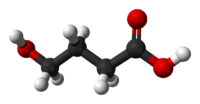GHB
GHB, also known as γ-Hydroxybutyric acid and 4-hydroxybutanoic acid, is a naturally occurring substance with depressant effects which is found in the human central nervous system, as well as in wine, beef, small citrus fruits, and in small amounts in almost all animals.[1]
GHB as the sodium salt, known as sodium oxybate (INN) or by the trade name Xyrem,[2] is used to treat cataplexy[3] and excessive daytime sleepiness in patients with narcolepsy. It has also been used in a medical setting as a general anesthetic, to treat conditions such as insomnia, clinical depression, narcolepsy, and alcoholism, and to improve athletic performance. It is also used as an intoxicant (illegally in many jurisdictions) or as a date rape drug.[4]
GHB is naturally produced in the human body's cells. As a supplement or drug, it is used most commonly in the form of a salt. GHB is also produced as a result of fermentation, and so is found in small quantities in some beers and wines. Succinic semialdehyde dehydrogenase deficiency is a disease that causes GHB to accumulate in the blood.
Chemistry
Pharmacology
GHB has at least two distinct binding sites[66] in the central nervous system. GHB is an agonist at the newly characterized GHB receptor, which is excitatory,[5][6] and it is a weak agonist at the GABAB receptor, which is inhibitory.[7]
GHB induces the accumulation of either a derivative of tryptophan or tryptophan itself in the extracellular space, possibly by increasing tryptophan transport across the blood–brain barrier. GHB-induced stimulation may be due to an increase in tryptophan transport to the brain and in its uptake by serotonergic cells. As the serotonergic system may be involved in the regulation of sleep, mood, and anxiety, the stimulation of this system by high doses of GHB may be involved in certain neuropharmacological events induced by GHB administration.
However, at therapeutic doses, GHB reaches much higher concentrations in the brain and activates GABAB receptors, which are primarily responsible for its sedative effects.[8] GHB's sedative effects are blocked by GABAB antagonists.
The role of the GHB receptor in the behavioural effects induced by GHB is more complex. GHB receptors are densely expressed in many areas of the brain, including the cortex and hippocampus, and these are the receptors that GHB displays the highest affinity for. There has been somewhat limited research into the GHB receptor; however, there is evidence that activation of the GHB receptor in some brain areas results in the release of glutamate, the principal excitatory neurotransmitter.[9] Drugs that selectively activate the GHB receptor cause absence seizures in high doses, as do GHB and GABAB agonists.[10]
Activation of both the GHB receptor and GABAB is responsible for the addictive profile of GHB. GHB's effect on dopamine release is biphasic.[11] Low concentrations stimulate dopamine release via the GHB receptor.[12] Higher concentrations inhibit dopamine release via GABA(B) receptors as do other GABA(B) agonists such as baclofen and phenibut.[13] After an initial phase of inhibition, dopamine release is then increased via the GHB receptor. Both the inhibition and increase of dopamine release by GHB are inhibited by opioid antagonists such as naloxone and naltrexone. Dynorphin may play a role in the inhibition of dopamine release via kappa opioid receptors.[14]
This explains the paradoxical mix of sedative and stimulatory properties of GHB, as well as the so-called "rebound" effect, experienced by individuals using GHB as a sleeping agent, wherein they awake suddenly after several hours of GHB-induced deep sleep. That is to say that, over time, the concentration of GHB in the system decreases below the threshold for significant GABAB receptor activation and activates predominantly the GHB receptor, leading to wakefulness.
Subjective effects
Physical effects
Cognitive effects
Toxicity and harm potential
Tolerance and addiction potential
Interactions
Legal issues
See also
References
- ↑ Weil, Andrew; Winifred Rosen (1993). "Depressants". From Chocolate to Morphine (2nd ed.). Boston/New York: Houghton Mifflin Company. p. 77. ISBN 0-395-66079-3.
- ↑ http://www.reuters.com/finance/stocks/companyProfile?rpc=66&symbol=JAZZ.O
- ↑ Sodium Oxybate | http://www.nlm.nih.gov/medlineplus/druginfo/meds/a605032.html
- ↑ GHB, GBL and 1,4BD as Date Rape Drugs | http://web.archive.org/web/20120510151441/http://www.justice.gov/dea//ongoing/daterapep.html
- ↑ γ-Hydroxybutyric acid (GHB) and γ-aminobutyric acidB receptor (GABABR) binding sites are distinctive from one another: molecular evidence | http://www.sciencedirect.com/science/article/pii/S0028390804002527
- ↑ A mechanism for γ-hydroxybutyrate (GHB) as a drug and a substance of abuse | http://www.medecinesciences.org/articles/medsci/abs/2005/03/medsci2005213p284/medsci2005213p284.html
- ↑ A mechanism for γ-hydroxybutyrate (GHB) as a drug and a substance of abuse | http://www.medecinesciences.org/articles/medsci/abs/2005/03/medsci2005213p284/medsci2005213p284.html
- ↑ Drosophila GABAB receptors are involved in behavioral effects of γ-hydroxybutyric acid (GHB) | http://www.sciencedirect.com/science/article/pii/S0014299905007442
- ↑ Selective γ-hydroxybutyric acid receptor ligands increase extracellular glutamate in the hippocampus, but fail to activate G protein and to produce the sedative/hypnotic effect of γ-hydroxybutyric acid | http://onlinelibrary.wiley.com/doi/10.1046/j.1471-4159.2003.02037.x/abstract
- ↑ Selective γ-hydroxybutyric acid receptor ligands increase extracellular glutamate in the hippocampus, but fail to activate G protein and to produce the sedative/hypnotic effect of γ-hydroxybutyric acid | http://onlinelibrary.wiley.com/doi/10.1046/j.1471-4159.2003.02037.x/abstract
- ↑ Drosophila GABAB receptors are involved in behavioral effects of γ-hydroxybutyric acid (GHB) | http://www.sciencedirect.com/science/article/pii/S0014299905007442
- ↑ A specific gamma-hydroxybutyrate receptor ligand possesses both antagonistic and anticonvulsant properties | http://www.ncbi.nlm.nih.gov/pubmed/2173754
- ↑ Tonic GABA-ergic modulation of striatal dopamine release studied by in vivo microdialysis in the freely moving rat | http://www.sciencedirect.com/science/article/pii/001429999500369V
- ↑ Gammahydroxybutyrate: An endogenous regulator of energy metabolism | http://www.sciencedirect.com/science/article/pii/001429999500369V

